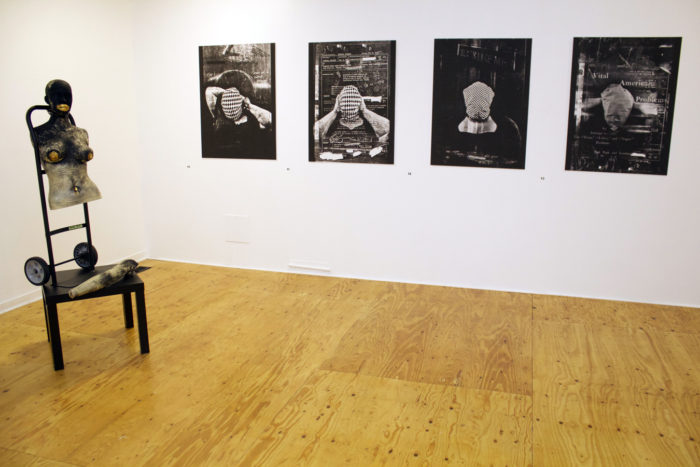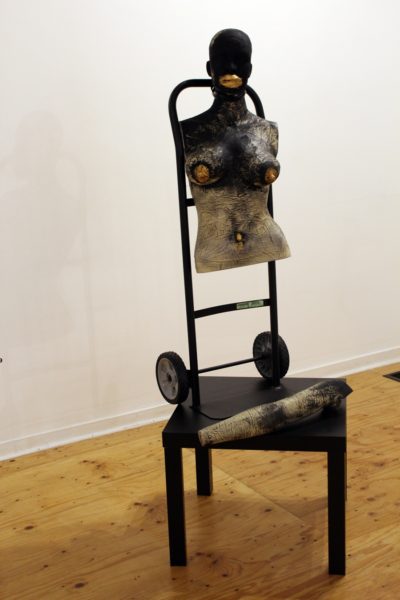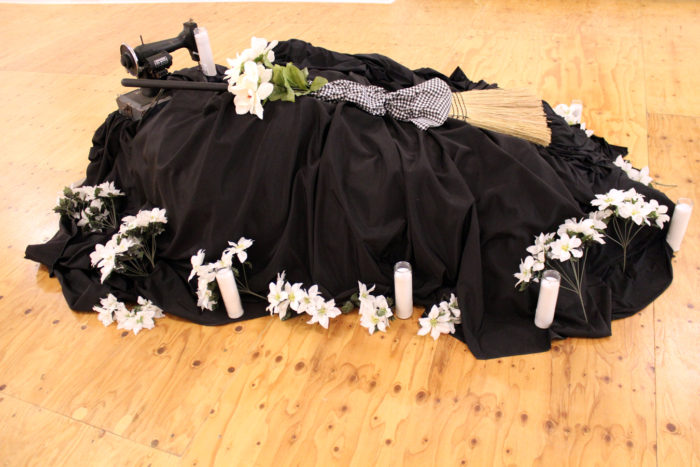
Born in Chicago, raised in Haiti, and educated in architecture and fine art in New Jersey, Dominique Duroseau is a black artist with a varied background. In her show at Gallery Aferro in Newark, she addresses the ongoing, intractable problem of racism in America, both institutionalized and individually expressed (we remember that Newark was the site of major riots in the summer of 1967, and is only now starting to reestablish economic vibrancy). Duroseau, who is in her mid-30s, draws upon what by now has become a black American tradition in visual culture, in which the artist educates, judges, and even ironically entertains the largely white audience that comes to see the exhibition or performance. Duroseau is deeply committed to confronting her viewers, who we assume are sympathetic to her point of view. So the situation is slightly strange; it has redundancy—social anger has by now a long history—and, as a result, its effect is known before the faceoff takes place, which is what happens when the minister preaches to the choir.

On the other hand, racism in America will not go away. It is embedded in our culture, in our history, and, given the sexual relations between white people and people of color over centuries, in our genes. So Duroseau is entirely right to maintain an aggressive, even an openly antagonistic, front. Her work is more than an artistic pose; it is a fierce cultural politics based on the ubiquity of prejudice. Sadly, her critique, like the work of other artists working in this manner, is displayed mostly to an art-world audience, which looks on with sympathy but can do little to change circumstances. Jeanne Brasile, a noted curator in the Newark/North Jersey area, organized the show; she is more than aware of how little art accomplishes in a social sense, outside the rarified atmosphere of the art world. Even so, Brasile has done an excellent job of presenting an artist who is determined to challenge cultural mores that are inherently biased but, even so, form part of today’s accepted culture.

For this writer, Duroseau’s sculpture stands out. Much of her three-dimensional work relates to assemblage, but the artist is using poor art materials—usually objects that might be found on the street: a hand truck, an old sewing machine, a bit of used fabric. In Eighteen Layers To Start (2017), the cluster of objects—a naked mannequin attached to a hand truck, which rests on a small end table, on top of which a long wooden dowel sits—promotes a social reading rather than a formal one. The mannequin has been painted black from just above the breasts to the top of the form’s bald head; the figure’s face shows off golden lips. Her partially painted breasts display large gold aureoles. The hand truck is lacking a bottom panel to stack things on; it reminds us, though, of the long history of simple labor reserved for many black Americans. What are we to make of this rough miscellany of things taken and hardly transformed? There is a deliberate degree of discomfort in this sculpture and, indeed, in Duroseau’s art in general. The blatant realism of the piece’s components, which are only marginally changed if at all, emphasizes a politics in which metaphorical meaning is rejected in favor of a literalism determined to make its point: that stereotypes die hard in America.

In The Feeling of Being Pretty, Alone (2017). Duroseau uses black satin and, at the top, black lace to bring into being a particularly sensitive fabric sculpture attached to the wall. The cloth is scrunched up into tight folds, while the lace above the fabric adds a filigree that is both beautiful and, also, vulnerable at the same time (maybe this reading comes from the implied pathos of the title). Here, instead of pushing against her audience, here Duroseau is gently engaging them. It is a personally appealing work of art, but in no way sentimental. Seen in light of the angrier art work, this sculpture feels like a respite from racial politics—for the artist as well as her audience. And Mammy Was Here: Patterns through Time (2017), which consists of four photos enhanced with digital collage, is related to a performance by Duroseau with the same name. All four images present a light-skinned black woman, clothed in a dark dress, wearing in three cases a black and white, checkered cloth covering her head and face, and in the last image to the right, a cloth of a single color. One senses that the sequence has to do with black anonymity in the face of casual prejudice; we recall the adjective in the title The Invisible Man, Ralph Ellison’s great novel.

These works and the rest in the show cannot quite be called identity art, although they certainly direct their energies toward the prevalence of bias toward black people. Duroseau’s work is specific in its orientation toward back culture, but, interestingly, it is not personal. Instead, she is creating experiences that don’t feel terribly private at all. I think this strengthens her art to a remarkable degree. To see the problem of racism as an indication of the big picture is to condemn it impersonally, rather than limiting it to a single person’s experience. Because racism is systematically embedded into American culture, Duroseau’s distanced, slightly impersonal approach emphasizes the problem in the largest manner possible. She could easily have individualized her complaint, but in fact she did not. Her art thus takes on tragic implications not only for her, but for generally for people of color. Strangely, the result is highly emotional rather than impartial, even though Duroseau takes pains to visualize prejudice as impartially as she can—the tension between private and public suffering, and its expression, becomes eloquent because so little is said and so much is implied. So Duroseau’s work is quite a bit more than a poke in the eye; it is an ardent call for fairness and freedom.
Dominique Duroseau: Black Things in White Spaces at Gallery Aferro
September 23rd – October 28th, 2017
Curated by Jeanne Brasile
-Jonathan Goodman
